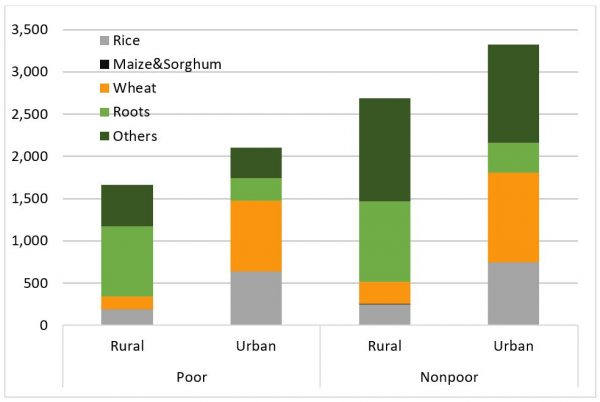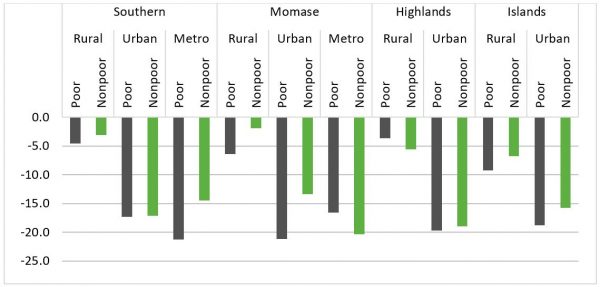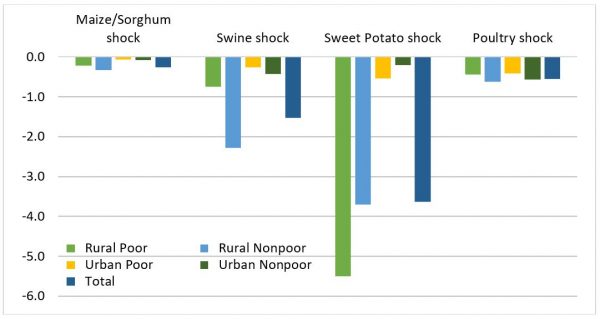
COVID-19 and other food shocks facing PNG
By Emily Schmidt, Xinshen Diao, Paul Dorosh and Peixun Fang
22 March 2021
COVID-19 has impacted urban and rural households throughout Papua New Guinea (PNG). Looking ahead, policymakers and development practitioners must continue to mitigate COVID-19 impacts on PNG households, as well as monitor other potential agricultural production shocks (such as El Niño, African Swine Fever, etc.) that could substantially decrease household income and food consumption.
Our recent study simulates the impact of a suite of COVID-19 shocks on the PNG food economy, as well as a set of potential agricultural production shocks. The model is designed to evaluate how the impact of these shocks differ by geographic region, income level and rural or urban area. The COVID-19 pandemic has presented a challenge far more complex than an agricultural production shock; however, both COVID-19 and a variety of climate and pest-related risks continue to threaten the PNG agri-food economy.
To understand the impact of the simulated shocks on household welfare and food security, we must first estimate the current baseline income and food consumption trends. Figure 1 displays the estimated average calories per person per day calculated using the data from the 2009/10 Household Income and Expenditure Survey (HIES), considering the modest growth in agriculture per capita between 2009 and 2018.
Figure 1: Estimated average calories per person per day from different sources of foods in PNG (2018)
Two important takeaways are shown in Figure 1:
- Rural and urban poor households consume considerably less calories than non-poor households, and less than the recommended 2,250 kilocalories per person per day.
- Households rely on different foods depending on where they live. Rural households consume disproportionally more root and tuber crops than urban households which consume more than twice as much rice as rural households.
Considering the average income and calorie consumption by household type, we design two sets of simulations to evaluate: (1) the impact of the COVID-19 pandemic; and (2) impacts of select agricultural production shocks. We summarise each in turn below.
COVID-19 simulations
Based on international price trends, conversations with international and domestic traders, and social distancing measures employed to curb the spread of COVID-19 in PNG, we designed the following simulations (results are discussed individually in this video presentation):
- 30% rise in the imported price of rice
- 60% decline in domestic poultry production
- 30% decrease in the price of major PNG agricultural exports
- 30% increase in domestic trade margins of internationally traded goods
- 30% increase in domestic trade margins for domestically traded goods
- A 10% decrease in urban household income
A final simulation calculates the combined effects of the above individual simulations. Results from the combined simulation suggest that urban households are particularly vulnerable to the impact of COVID-19 and related social distancing policies. Urban poor and non-poor households experience a 19.8 and 15.8% (respectively) decline in calorie consumption due to lower economic activity (urban job loss), increases in marketing costs, and increased imported rice prices (Figure 2). Rural households are affected less but still experience reductions in income and consumption within an already vulnerable socio-economic environment.
Figure 2: Percentage changes (from baseline) in total calorie intake per person per day
Agricultural production shocks simulations
In contrast to the COVID-19 simulation results, the agricultural production shock simulations underline the vulnerability of rural households (representing more than 80% of the population). We simulate the following risks that are monitored by the PNG Department of Agriculture and Livestock Food Security Cluster:
- El Niño (similar to 2015/16) decreasing sweet potato production by 25% in the Highlands
- African Swine Fever reducing swine production by 50%
- Fall Armyworm infestation decreasing maize and sorghum production by 50%
- Decline in domestic poultry production of 60% (reflecting scenarios reported due to COVID-19)
Each of the above simulations result in a decline in household incomes across all household groups (rural, urban, poor and non-poor households) at the national level. Rural incomes fall because the decrease in agricultural production directly affects rural income. The negative effect on urban household incomes reflects a reduction in consumption (demand) for all goods, both agricultural and non-agricultural. Reduced demand leads to lower prices for non-tradable non-agricultural goods, which discourages production of these goods, and ultimately reduces urban incomes.
Production shocks also lead to reduced calorie consumption, particularly among rural households (Figure 3). Rural households’ calorie consumption falls sharply (by -3.7% in non-poor households to -5.5% in poor households) when production of sweet potatoes in the Highlands region declines (due to a simulated El Niño shock). Given that sweet potato is an important staple in the rural PNG diet, a drop in production on this commodity results in more acute reductions in calorie intake. Comparing the different simulations across household groups, rural households (both poor and non-poor) are particularly vulnerable to a significant El Niño (or La Niña) event or a major African Swine Fever outbreak.
Figure 3: Percentage changes (from baseline) in calories per person per day due to selected production shocks
Summary and policy implications
Urban households, especially the urban poor, in PNG are the most affected by the COVID-19 pandemic. Lower economic activity in urban areas, increases in marketing costs due to domestic trade disruptions, and 30% higher imported rice prices combine to lower urban incomes by almost 15%. Urban poor households suffer the largest drop in calorie consumption – 19.8%. Rural households are less affected by the COVID-19 related shocks modelled in these simulations. Nonetheless, calorie consumption for the rural poor and non-poor falls by 5.5 and 4.2%, respectively.
Agricultural production shocks (e.g., El Niño, pest infestation, African Swine Fever) have a larger impact on rural incomes and food consumption. A simulated 25% reduction in sweet potato production in the Highlands, as occurred in the 2015/16 El Niño event, leads to an average drop in total calorie consumption of 5.5 and 3.7% for the rural poor and non-poor, respectively. Given that over 80% of PNG’s population lives in rural areas, programs to increase rural household and community resilience to shocks and improve emergency assistance mobilisation are needed. We outline a few recommendations:
- A set of well-targeted safety net programs for particularly vulnerable households, pregnant and lactating women, and young children should be considered. These programs should be accompanied by robust design and evaluation methods to understand what type of service delivery is most effective and efficient in remote rural locations.
- Investments in market infrastructure (e.g., roads, ports, and food market infrastructure) could lower marketing costs and benefit both producers and consumers.
- More data collection and analysis are needed to better understand the market inter-connections between regions and across agricultural products. Improved household and production data are also crucial to better inform agriculture sector policy and build resilience against potential agri-food shocks.
Read the discussion paper here.
About the author/s
Emily Schmidt
Emily Schmidt is a Research Fellow at the International Food Policy Research Institute.
Xinshen Diao
Xinshen Diao is the Deputy Division Director and a Senior Research Fellow at the International Food Policy Research Institute.
Paul Dorosh
Paul A. Dorosh is Division Director, Development Strategy and Governance Division, at the International Food Policy Research Institute.
Peixun Fang
Peixun Fang is a Research Analyst at the International Food Policy Research Institute.



